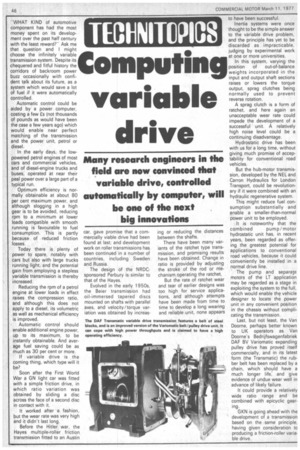TENNITUP108
Page 50

If you've noticed an error in this article please click here to report it so we can fix it.
Computing variabl drive
-WHAT KIND of automotive component has had the most money spent on its development over the past half century with the least reward?'' Ask me that question and I might choose the infinitely variable transmission system. Despite its chequered and fitful history the corridors of backroom power buzz occasionally with confident talk about its future, as a system which would save a lot of fuel if it were automatically controlled.
Automatic control could be aided by a power computer, costing a few Es (not thousands of pounds as would have been the case a few years ago) which would enable near perfect matching of the transmission and the power unit, petrol or diesel.
In the early days, the lowpowered petrol engines of most cars and commercial vehicles, and of diesel-engine trucks and buses, operated at near their peal power over a large part of a typical run.
Optimum efficiency is normally obtainable at about 80 per cent maximum power, and although slogging in a high gear is to be avoided, reducing rpm to a minimum at lower loads compatible with smooth running is favourable to fuel consumption. This is partly because of reduced friction losses.
Today there is plenty of power to spare, notably with cars but also with large trucks running light, and the potential gain from employing a stepless variable transmission is thereby increased.
Reducing the rpm of a petrol engine at lower loads in effect raises the compression ratio, and although this does not apply to a diesel, its volumetric as well as mechanical efficiency is improved.
, Automatic control should enable additional engine power, up to its maximum, to be instantly obtainable. And average fuel saving could be as much as 30 per cent or more. If variable drive is the coming thing, which type will it be?
Soon after the First World War a GN light car was fitted with a simple friction drive, in which ratio variation was obtained by sliding a disc across the face of a second disc in contact with it.
It worked after a fashion, but the wear rate was very high and it didn't last long.
Before the Hitler war, the Hayes multiple-roller friction transmission fitted to an Austin car, gave promise that a commercially viable drive had been found at last; and development work on roller transmissions has been continued in a number of countries, including Sweden and Russia.
The design of the NRDCsponsored Perbury is similar to that of the Hayes.
Evolved in the early 1950s, the Beier transmission had oil-immersed tapered discs mounted on shafts with parallel axes, and velocity/torque variation was obtained by increas ing or reducing the distances between the shafts.
There have been many variants of the ratchet type transmission, and promising results have been obtained. Change in ratio is provided by adjusting the stroke of the rod or mechanism operating the ratchet. But the rate of ratchet wear and tear of earlier designs was too high for service applications, and although attempts have been made from time to time to develop a long wearing and reliable unit, none appears to have been successful.
Inertia systems were once thought to be the simple answer to the variable drive problem, and the principle has yet to be discarded as impracticable, judging by experimental work at one or more universities.
In this system, varying the position of out-of-balance weights incorporated in the input and output shaft sections raises or lowers the torque output, sprag clutches being normally used to prevent reverse rotation.
A sprag clutch is a form of ratchet, and here again an unacceptable wear rate could impede the development of a successful unit. A relatively high noise level could be a continuing disadvantage.
Hydrostatic drive has been with us for a long time, without giving much promise of acceptability for conventional road vehicles.
But the hub-motor transmission, developed by the NEL and Carron Hydraulics for London Transport, could be revolutionary if it were combined with an hydraulic regenerative system.
This might reduce fuel consumption substantially and enable a smaller-than-normal power unit to be employed.
It is noteworthy that the combined pump/motor hydrostatic unit has, in recent years, been regarded as offering the greatest potential for applications to conventional road vehicles, because it could conveniently be installed in a normal drive line. The pump and separate motors of the LT application may be regarded as a stage in exploiting the system to the full, which would enable the vehicle designer to locate the power unit in any convenient position in the chassis without complicating the transmission.
Last, but not least, the Van Doorne, perhaps better known to UK operators as Van Doorne's Bedrijfswagenfabriek DAF BV Variomatic expanding pulley drive has proved itself commercially, and in its latest form (the Transmatic) the rubber belt has been replaced by a chain, which should have a much longer life, and give evidence of undue wear well in advance of likely failure.
It could provide a relatively wide ratio range and be combined with epicyclic gearing.
GKN is going ahead with the development of a transmission based on the same principle, having given consideration to producing a friction-roller variable drive.






















































































































